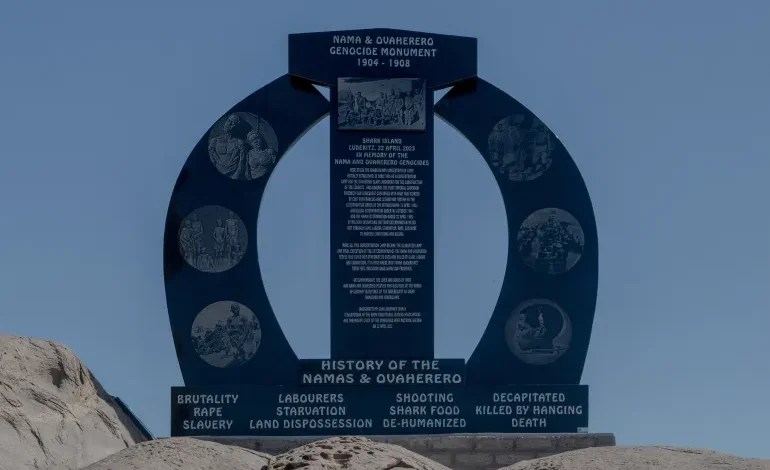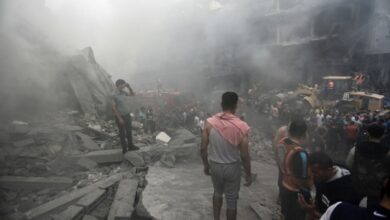How to pay for genocide: Namibian victims of German colonialism want a say

South of Berlin, the expansive Treptower Park stretches out alongside the Spree river – an oasis of tranquillity in an otherwise restless city. On a recent Saturday, small groups of people strolled along the paths, and on the river, a boat fitted with a jacuzzi floated lazily by. Towering trees, a combination of rust browns, greens and yellows against a grey sky, shook off tired leaves that carpeted the ground.
The park, idyllic now, belies a dark past. Some 127 years ago, dozens of people pried away from their homes, were displayed in ethnological expositions or “human zoos” here and in other parts of the city to signal Germany’s entry into the colonial venture. Some of those exhibited were from colonies in South, East, and West Africa where violence was crucial to keeping the occupation in place.
In southwest Africa, German settlers were pushing Indigenous people off their lands. When two ethnic groups rebelled and fought back, the Schutztruppe – or colonial guards – responded with such brute force that they almost wiped them out entirely. The massacre of the Nama and Herero peoples between 1904-1908, now in present-day Namibia, is widely recognised as an intentional extermination attempt.
In May 2021, three years after the German government formally apologised for the massacres, the country announced a framework to address the tragedy. The scheme would see Namibia get 1.1 billion euros ($1.2bn) in “development aid”, with 50 million euros ($54m) set aside for research, remembrance and reconciliation projects, with the rest marked for the development of affected descendants’ communities.
“Germany asks for forgiveness for the sins of their forefathers,” the Joint Declaration issued by the German and Namibian authorities read, and “the Namibian Government and people accept Germany’s apology.”
The agreement was supposed to be a win-win. Germany would atone for its bloody crimes and Namibia would get needed funding. But for the surviving communities, it was a betrayal. Protests broke out in the Namibian capital, Windhoek, as people vehemently opposed the agreement, saying it was dictated by Germany.
“I think the first response of the community was just total shock – so violent, so cruel, that what it (the declaration) did was re-traumatise us again,” says Sima Luipert, an adviser to the Nama Traditional Leaders Association (NTLA). Luipert, like many in the affected communities, says recognised members of the Nama and Herero were not present at the table and that the two governments were forcing the agreement upon them.
“This was not a trilateral process. It was a bilateral process, so the document defeats its purpose and it lacks legitimacy because the legitimate people are not at the table,” Luipert says.
The case underscores the challenges of righting historical injustices in ways that are acceptable to, and inclusive of the very people who were wronged.
In January, lawyers representing the survivor communities sued Namibian authorities at the high court in Windhoek, urging the court to declare the agreement unlawful and thus, invalid. The suit is one of the rare cases globally – perhaps the only one – in which a court in a former colony passes judgement on the colonial power that ruled it. Although directly binding only on Namibia, the top court’s judgement could derail Germany’s attempts to rid itself of decades of colonial guilt by forbidding Windhoek from receiving those funds.
Almost a year after it was filed though, the suit is frozen in “Status Hearing” – legal speak for a case suspended so the prosecuting party can gather more documents and draw a road map for its arguments. There have been no trials or seatings and Germany has so far disregarded the suit, promising instead to press on with its plans.
Patrick Kauta, the lawyer who filed the suit, did not respond to Al Jazeera’s requests for comment.
Carrying a painful history
The arid southwest African region was home first to the San, then later, to the cattle-farming Herero and Nama people as far back as the 16th century. This was some 400 years before German missionaries came and before German settlers started acquiring land from Indigenous chiefs there. Following the partition of Africa by European powers in the 1885 Berlin Conference, Germany officially laid claim to the area.
As settlers and colonists continued to descend on the region, enthralled by the prospects of diamonds they would later discover, they restricted the Indigenous nations to “reserves”, confiscating their land and cattle despite their resistance.
In January 1904, the Herero staged a stunning revolt and invaded Okahandja – one of the biggest German settlements and the heart of Hereroland. Mounted on horses, they killed dozens of settlers and torched their homes, according to one account. The war raged for months, spreading to other cities. The Nama also joined the battle alongside the Herero, despite previous rivalry.
Although the war favoured them at first, the revolters ultimately faced defeat. People died in their thousands, some driven into British territory in present-day Botswana and South Africa.
Yet, when they signalled peace by heeding calls to assemble in certain locations from the well-trusted German missionaries who arrived way ahead of the colonialists, the German soldiers would not let up. On October 2, 1904, German military commander General Lothar von Trotha issued a chilling call to his troops: “…every Herero, with or without a gun, with or without cattle, will be shot. I will no longer accept women and children, I will drive them back to their people or I will let them be shot at.”
German troops – numbering about 1,500 under the command of von Trotha – encircled the weakened fighters and forced them into the desert, the waterless Omaheke region, trapping them, Herero descendant Laidlaw Peringanda, who heads the Namibian Genocide Association (NGA), says. When those fleeing dug wells, the Germans snuck up and poisoned the water. Survivors of the thirst and slaughter – including those who listened to the missionaries and peacefully assembled – were then rounded up and forced into concentration camps.
In the camps, women pulled ropes tied to train cars with their bare hands. Often, they were raped and hung naked from trees. Insubordination, for men, meant firing squads. The colonialists would also force the women to scrape the skin off corpses so their skulls could be sent to Germany. Cultural artefacts were looted.
“They rented out the women to German companies and German settlers who would pay the German administration and not the workers,” Luipert says. Her own great-grandmother was “rented” to a settler who violently abused her and got her pregnant.
By the time the camps were shut in 1908, about 80 percent of the 90,000 Hereros, and about half of the 20,000 Nama population, had perished. Some 100,000 people were killed in total.
Some historians link the atrocities of that war to the methods later used in the mass extermination of European Jews: the death camps in Shark Island, Swakopmund and Windhoek were similar to the concentration camps in Europe. Medical experiments – now discredited – were also done on the remains of Nama and Herero people during the Holocaust, to show the supposed racial superiority of whites.
Skulls and skin fragments from Namibia and other former German colonies are still kept in museums, hospitals and universities across Germany. In 2018, German authorities handed over 19 skulls, five full skeletons, as well as bone and skin fragments to Namibian descendants in a ceremony in Berlin.
A legacy of landlessness
Generations later, the affected communities are still reeling from the effects of German colonisation, and the question of land is perhaps the sorest issue of all.
As a child, Peringanda listened to his great-grandmother describe what happened to their family wealth. Theirs was a powerful Herero family before the genocide started in 1904, he says, but after they were forced into labour, the German occupiers announced decrees that assigned all communal land belonging to the two ethnic groups to settlers. Peringanda’s family lands in the region of Otjozondjupa, as well as thousands of cattle, were gone.
“Till today, I know the family that took over this land,” says Peringanda, of the NGA. He has tried to petition the family, Namibian authorities, as well as the German government, he says, but to no avail.
“They said there’s no evidence that we had the land, but I have all the evidence,” Peringanda says. Missionary Carl Hugo Hahn, who led missions into South West Africa at the time, documented the lives of the population. One of those he wrote about was the great Herero chief Mungunda wo Otjombuindja – Peringanda’s great-grandfather. “Hahn wrote that Chief Mungunda was a wealthy man who owned over 20,000 cattle and (that) he controlled the area between Okahandja, Omaruru and Otjimbingwe,” the activist added.
The life of Kambazembi wa Kangombe, too, the Herero chief who lived around the Waterberg area – which the Hereros would later lose to the Germans – and who fiercely opposed selling communal land to settlers, is well documented. Kangombe, Peringanda says, was his uncle.
German descendants now occupy thousands of acres belonging to his forebears and claim to have legally bought them, but neither those occupiers, nor the German authorities Peringanda has written to, have provided any evidence of a sale.
“The descendants of the white settlers continue to live in mansions while the descendants of the enslaved people live in informal settlements here,” says Peringanda.
Although it’s a middle-income country, Namibia is also one of the most unequal countries in the world.
Today, German Namibians make up 2 percent of Namibia’s 2.5 million population but own about 70 percent of the country’s land, most of it used for agriculture. Multiple state-led efforts to legally restore ancestral land to Indigenous peoples by buying land from private farmers have only partially succeeded because it has proven too expensive for the state. Although the Namibian government sought to transfer 43 percent (15 million hectares) of its total arable land to landless communities by 2020, it has only succeeded in acquiring about three million hectares.
Inequalities extend to remembrance, too. In “Little Germany”, as the seaside resort city of Swakopmund is sometimes called, owing to its German population and architecture, monuments carry the names of colonial soldiers who put down the rebellion. But the concentration camps where thousands of Herero and Nama people perished have turned to campsites, and the unmarked, shallow graves of those killed in the genocide are falling apart, the mounds of sands shifting often to reveal human remains.
It’s why Peringanda founded the Swakopmund Genocide Museum in 2015, and why he makes a quarterly pilgrimage to the unmarked graves.
“Four times a year we take a shovel and restore the grave and cover the remains with sand,” Peringanda says. When he does it, he says he feels an overpowering sense of loss. “The first time I went, I fainted,” he said.
Imperial Germany also severely exploited the former colony economically, experts say. After the war, Germans discovered diamonds in the area in 1908 and proceeded to mine so much of the mineral that they engineered a worldwide culture of using diamonds to profess love. At the height of the trade, the German empire controlled 30 percent of the world’s diamonds.
“Many of the property and mining ownership rights drawn up by German colonial authorities are still in place in today’s postcolonial Namibia,” says Steven Press, an author and Stanford University history researcher. And contracts, in the past or today, “do not include any mechanism for Nama, in particular, to partake of the wealth that was located on their land”, he adds.
Following Germany’s defeat in World War I, German South West Africa was placed under the control of British-occupied South Africa, which proceeded to entrench its own apartheid system in a region already ripe with inequalities. The Hereros and Namas, for one, remained on reserves as South African occupiers transferred Dutch settlers to the area’s most fertile lands.
Activists like Peringanda hope that by reworking a reparations framework, German and Namibian governments might adequately tackle the land issue. The declaration agreement mentions land reform and notes that “a separate and unique reconstruction and development support programme will be set up”.
There is palpable dissatisfaction within youths in disadvantaged and survivor communities who see the stark inequalities in their country as holding them back, Peringanda says. He wants the German government to buy back the disputed land and redistribute it to his people. The amount already bought back by the Namibian government is not nearly enough for Peringanda. Although the controversial Joint Declaration addresses “land acquisition,” it does not lay out specifics.
“We want back all our ancestral land,” Peringanda says. Delay, he warns, could spell trouble.
“We fear that there might be a revolt and people will be forced to seize land,” he says. “Before that happens, we need to go back to the drawing board and start the talks again.”










